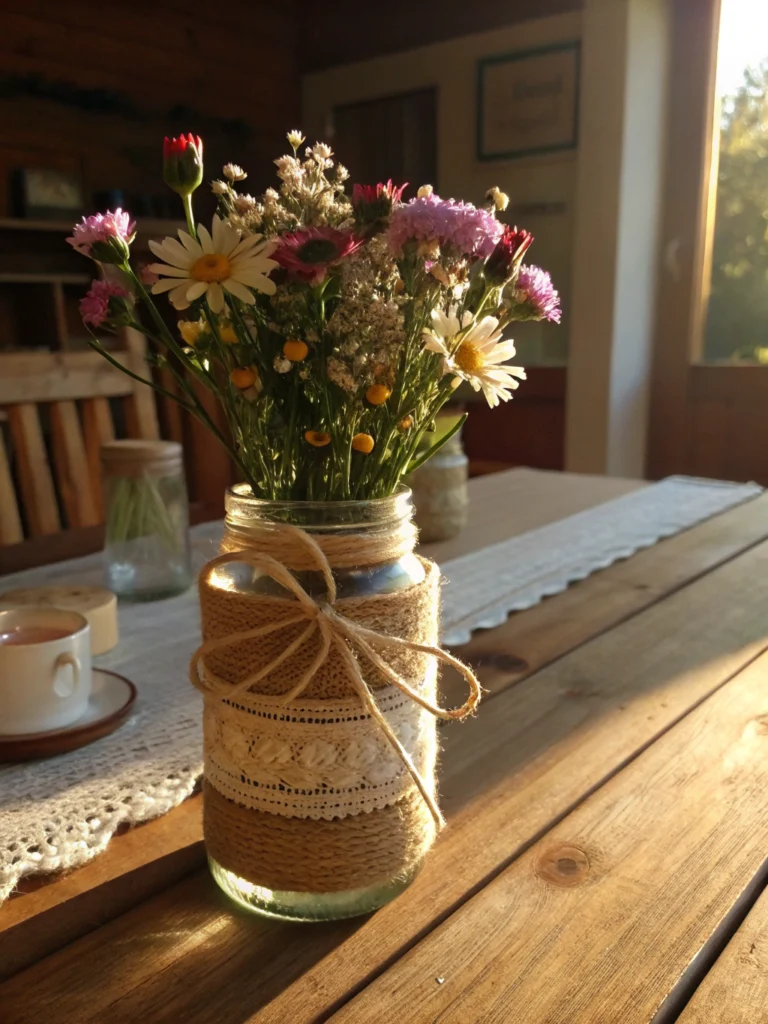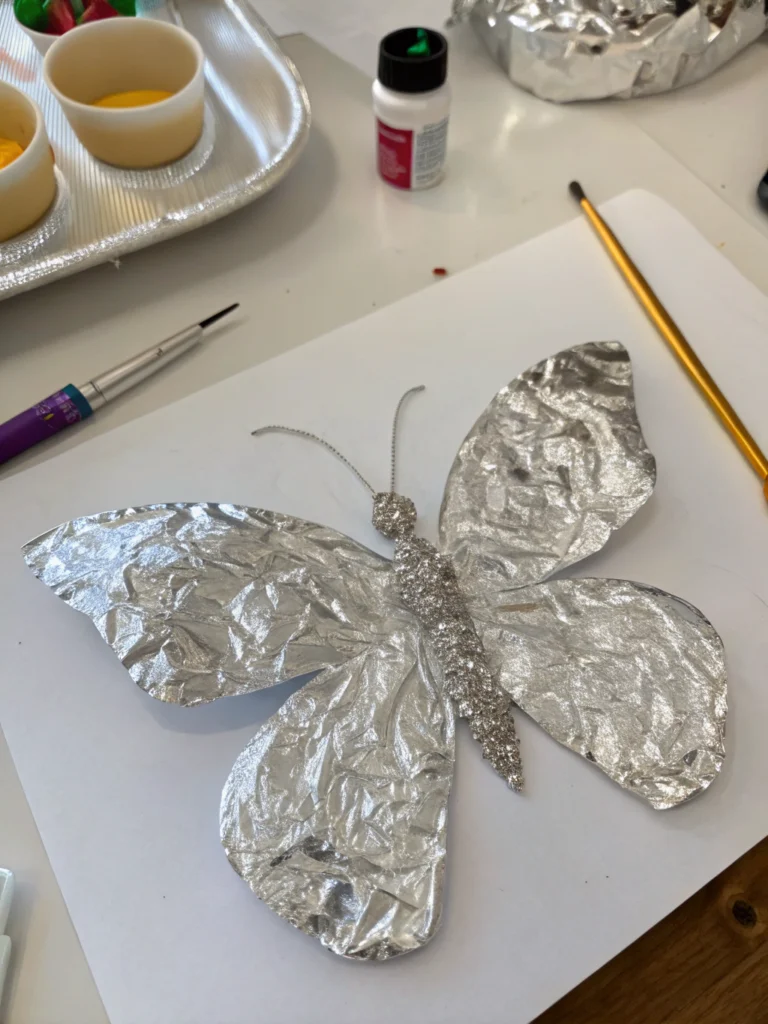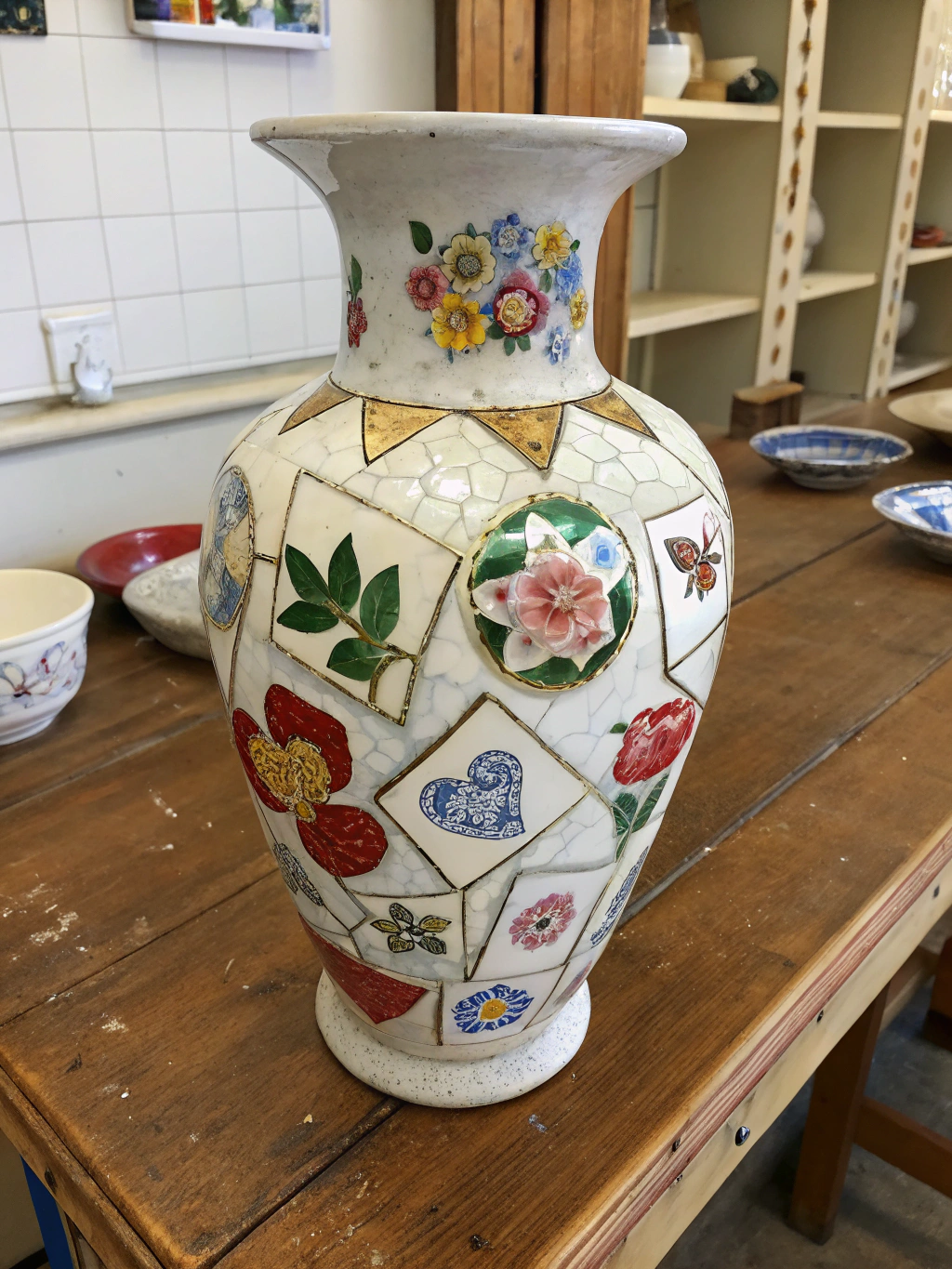
*Caption: Transform shattered memories into beautiful new treasures. Let’s show you how to upcycle broken china!*
Introduction: From Shattered to Spectacular
That heart-sinking CRASH! We’ve all been there. A cherished teacup slips, a favorite plate meets the floor, and suddenly, you’re left with a pile of beautiful, but broken, pieces. Before you sweep those fragments into the bin, pause for a moment. What if you could transform that mishap into a masterpiece? Learning how to upcycle broken china is not just about salvaging sentimental items; it’s a gateway to unlocking your creativity and giving new life to what seems lost.
This guide will walk you through five inspiring DIY projects, turning those unfortunate breaks into opportunities for stunning, unique creations. Get ready to explore some fantastic “Upcycle broken china ideas, Creative DIY with broken china, How to upcycle broken china projects” and discover the joy of making something beautiful from “broken.”
Upcycle Broken China
Table of Contents
Why Upcycle Broken China? More Than Just a Craft
You might be wondering, “Why bother with tiny, sharp pieces?” The reasons to upcycle broken china are as varied and beautiful as the patterns on the china itself! Firstly, there’s the sentimental value. Many broken pieces come from heirlooms or beloved gifts. Transforming them means you’re not just crafting; you’re preserving memories in a new, tangible form.
Secondly, it’s an wonderfully sustainable practice. In a world increasingly conscious of waste, choosing to upcycle broken china diverts material from landfills. It’s a small but significant step towards a more eco-friendly lifestyle, aligning perfectly with the ethos of thoughtful DIY.
Lastly, the creative possibilities are virtually endless! Each shard tells a story with its color, pattern, and shape. These aren’t just “broken” pieces; they are unique mosaic tiles gifted to you by fate. From delicate jewelry to robust garden art, the projects you can undertake are limited only by your imagination. This is your chance to create truly one-of-a-kind items that reflect your personal style and crafting prowess. Embracing “Creative DIY with broken china” projects allows for an artistic expression that’s both personal and beautiful.
Safety First: Handling Upcycle Broken China with Care
Before we dive into the exciting projects, let’s talk safety. Working with broken china means dealing with sharp edges, so protecting yourself is paramount. Don’t let this intimidate you; with a few simple precautions, you can enjoy your crafting experience safely.
- Gloves are a Must: Always wear thick, protective gloves (gardening gloves or heavy-duty work gloves work well) when handling broken china pieces. This will protect your hands from cuts and nicks.
- Eye Protection: Tiny shards can fly off when breaking china further or when pieces shift. Always wear safety goggles or glasses to protect your eyes.
- Work Surface: Cover your work surface with newspaper or an old cloth. This makes cleanup easier and helps contain small, sharp fragments.
- Breaking China (If Needed): If you need to break larger pieces into smaller ones, place them inside a sturdy cloth bag or wrap them in a thick towel. Gently tap with a hammer. This contains the shards and prevents them from scattering.
- Smoothing Edges: If you’re concerned about particularly sharp edges, you can gently sand them down using a Dremel with a grinding stone attachment, or even a sturdy metal file or rubbing stone (like a carborundum stone). Do this outdoors or in a well-ventilated area, wearing a dust mask.
- Disposal of Unused Shards: Carefully wrap any unused sharp pieces in several layers of newspaper and tape securely before disposing of them in your regular trash, or check local guidelines for glass disposal.
Prioritizing safety ensures your journey to upcycle broken china is enjoyable from start to finish.
Getting Started: Essential Tools and Materials for Upcycling Broken China
Having the right tools and materials on hand will make your upcycle broken china projects smoother and more successful. While each project might have a few specific needs, here’s a general list to get you started:
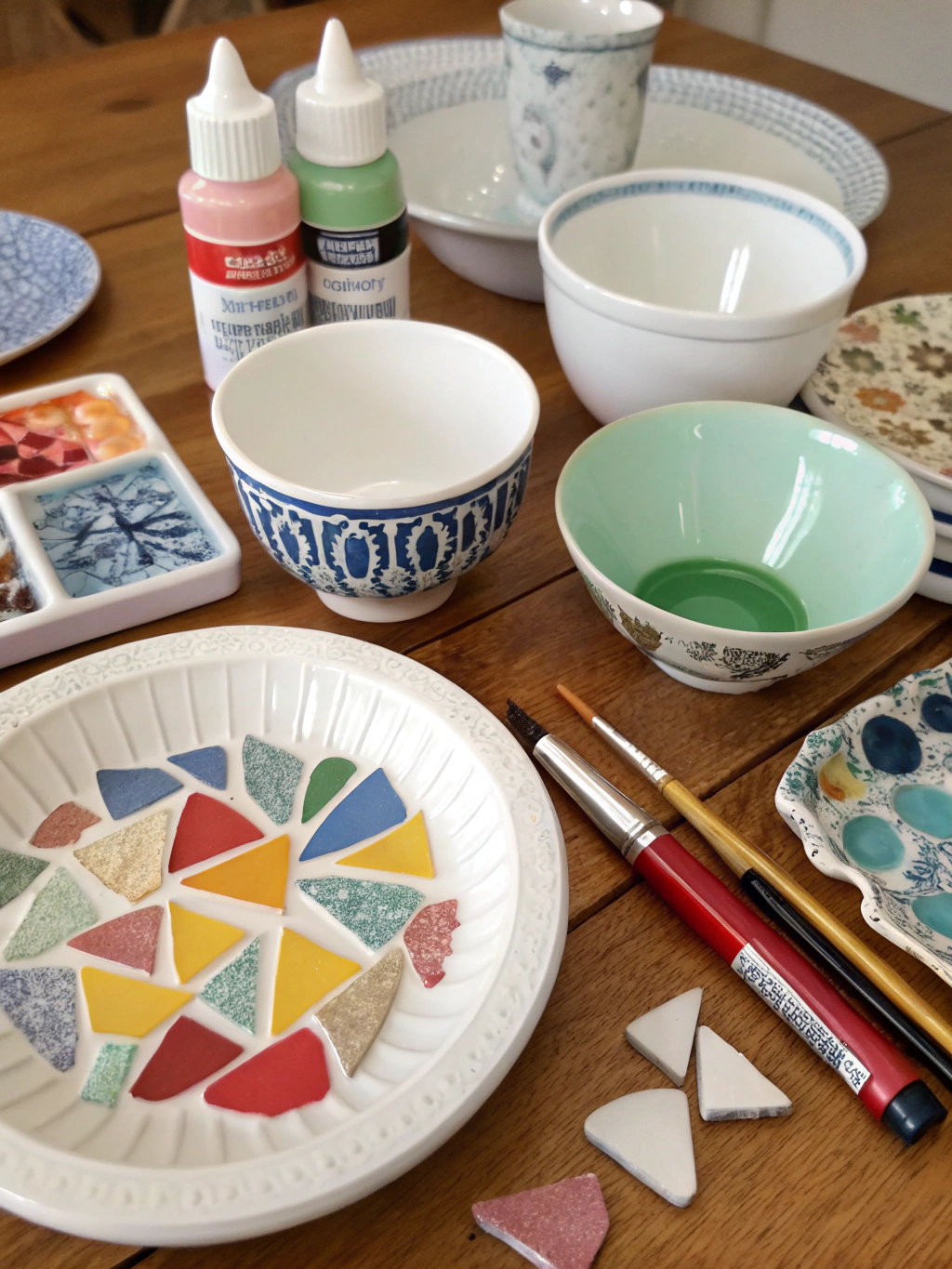
*Caption: Gather these essentials, and you’re ready to tackle your first upcycled china project!*
Materials: Upcycle Broken China
- Broken China: Of course! Collect your sentimental pieces or even pick up interesting chipped plates from thrift stores.
- Adhesive:
- Strong Craft Glue/Epoxy Resin: For joining pieces or attaching them to surfaces. E6000 is a popular choice for its strength and versatility. For mosaics, tile adhesive is key.
- Weldbond Universal Adhesive: Great for mosaics as it dries clear and is non-toxic.
- Grout: For mosaic projects, you’ll need powdered grout (sanded or unsanded, depending on the gap size) and water to mix it. You can also find pre-mixed grout.
- Bases for Your Projects: This could be anything – wooden boards, picture frames, stepping stone molds, terracotta pots, jewelry bezels.
- Sealant (Optional): For outdoor projects or items that might get wet, a clear waterproof sealant will protect your work.
Tools: Upcycle Broken China
- Safety Gear: As mentioned above – heavy-duty gloves and safety goggles.
- Hammer: For breaking down larger china pieces (use with a cloth or bag).
- Tile Nippers: These are invaluable for shaping china pieces more precisely for mosaic work. They give you much more control than a hammer.
- Old Towel or Sturdy Cloth Bag: To contain china while breaking it.
- Spatula or Putty Knife: For spreading adhesive or grout.
- Sponges and Soft Cloths: For cleaning off excess grout and polishing your finished pieces.
- Mixing Containers: For grout or resin. Disposable ones are handy.
- Stirring Sticks: For mixing adhesives and grout.
- Tweezers: Useful for placing small, delicate china pieces.
- Dust Mask: Especially if sanding edges or working with powdered grout.
- Pencil or Marker: For outlining designs.
With these supplies, you’re well-equipped for a variety of “How to upcycle broken china projects”.
5 Creative DIY Projects to Upcycle Broken China
Now for the fun part! Let’s explore five creative ways to transform those shards into something beautiful and new. Each project offers a different way to showcase the unique charm of your broken china.
Project 1: Stunning Mosaic Stepping Stone
Turn your garden path into a gallery of memories with a custom mosaic stepping stone. This is a fantastic beginner-friendly project that yields impressive results.
Specific Materials:
- Broken china pieces
- Round or square stepping stone mold (or use a sturdy plastic plant saucer as a mold)
- Quick-setting concrete mix
- Petroleum jelly (to coat the mold for easy release)
- Tile nippers (optional, for shaping pieces)
- Bucket for mixing concrete
- Trowel or sturdy stick for mixing
Step 1: Prepare Your China and Mold
First, ensure your china pieces are relatively clean. If you need smaller or more specifically shaped pieces, now’s the time. Wearing your safety gloves and goggles, place larger china pieces inside a heavy cloth or bag and gently tap with a hammer until you have a variety of sizes. For more control, use tile nippers to shape individual pieces. Aim for pieces that are relatively flat on one side.
Next, prepare your mold. Lightly coat the inside of your stepping stone mold with petroleum jelly. This will act as a release agent, making it much easier to remove the cured stone later.
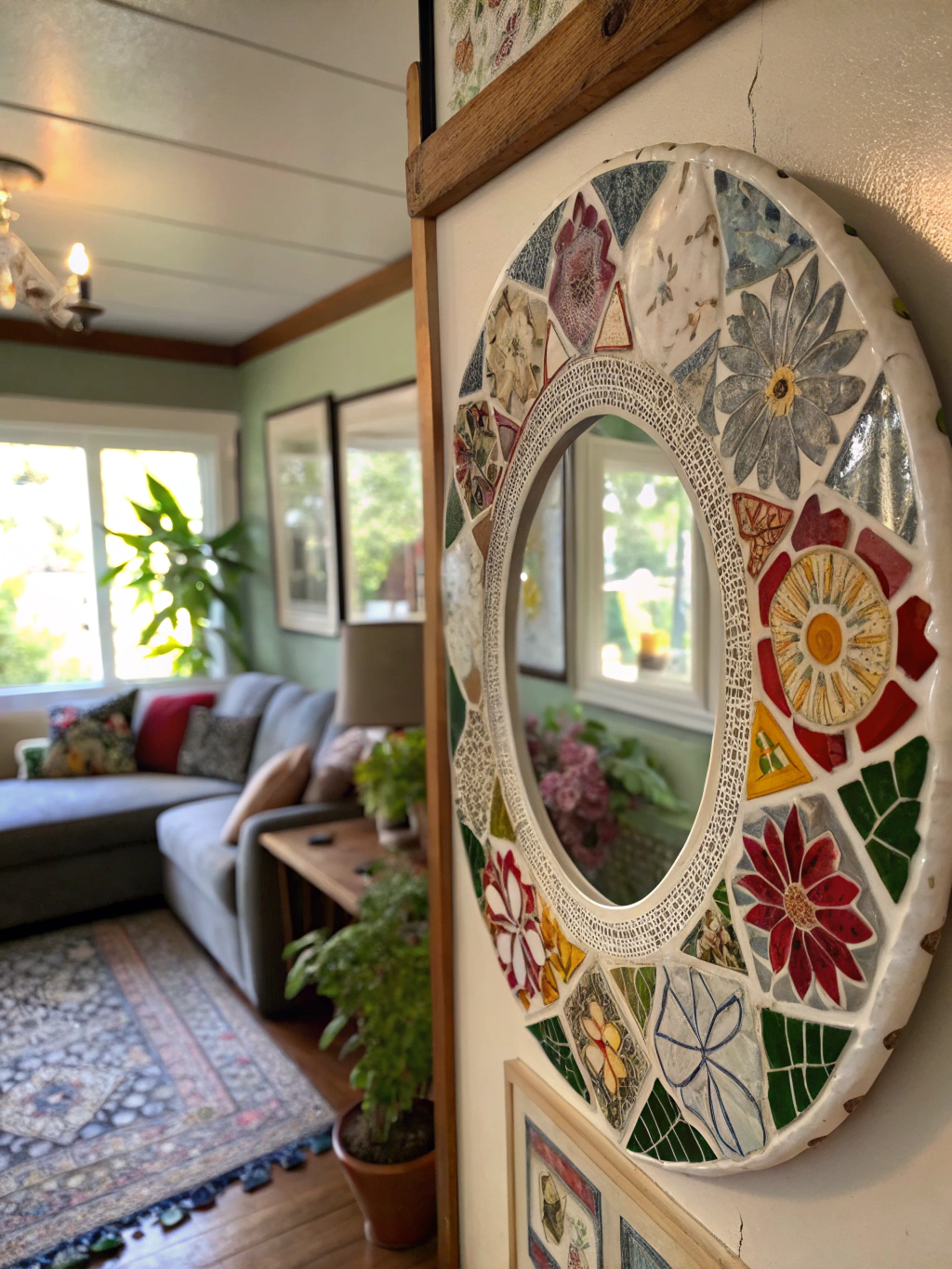
*Caption: Step 1 involves carefully preparing your china shards, ready for their new purpose in your upcycle broken china creation.*
Step 2: Arrange Your Design (Optional Dry Run)
Before mixing the concrete, you might want to do a “dry run” of your design. Place your mold on a flat surface and arrange your china pieces inside it, face down (the pretty side facing the bottom of the mold). This way, you can play with patterns and spacing until you’re happy. You can take a quick photo to remember your layout. Once satisfied, carefully remove the pieces, keeping them in their general arrangement.
This step helps visualize the final outcome and prevents rushing when the concrete is setting. It’s a good practice for many “Creative DIY with broken china” endeavors.
Step 3: Mix and Pour Concrete
Following the instructions on your concrete mix package, combine the powder with water in your bucket. Mix thoroughly with a trowel or stick until it reaches a thick, oatmeal-like consistency. It should be pourable but not too watery.
Carefully pour a layer of concrete into your prepared mold, about 1/2 to 1 inch thick, depending on the depth of your mold and the thickness of your china. Gently tap the mold on your work surface to release any air bubbles and help the concrete settle.
Step 4: Embed Your China Pieces
Now, working relatively quickly before the concrete begins to set, press your china pieces into the wet concrete, pretty side up (if you didn’t do the dry run with pieces face down). Ensure they are pressed in firmly enough to be secure but not so deep that concrete oozes over the top surface too much. Try to keep the top surfaces of the china pieces relatively level with each other for a smoother final stone.
If you did a dry run with pieces face down, you’d pour all the concrete in, then place your pre-arranged design (still on its backing paper, if you used one) onto the wet concrete, pressing gently.
Step 5: Cure and Demold
Let the concrete cure according to the manufacturer’s instructions, typically 24-48 hours. It’s important to let it cure fully for maximum strength. Keep it in a spot where it won’t be disturbed.
Once cured, gently flex the mold or tap it upside down to release the stepping stone. The petroleum jelly should make this fairly easy. Brush off any loose concrete dust. If desired, you can further clean the china surfaces with a damp cloth. Your beautiful, custom stepping stone, a testament to your skills to upcycle broken china, is ready for the garden!
Project 2: Elegant Upcycle Broken China Jewelry (Pendants & Earrings)
Transform delicate china fragments into unique and wearable art. This is perfect for smaller, especially pretty pieces of china.
Specific Materials:
- Small, interesting broken china pieces
- Jewelry bails (pre-made metal loops to hang pendants)
- Earring posts and backs, or earring hooks
- Strong adhesive (E6000 or a two-part epoxy suitable for jewelry)
- Rotary tool (like a Dremel) with a small grinding/sanding bit (optional, for smoothing edges)
- Fine sandpaper (optional)
- Jewelry pliers (for attaching hooks)
Step 1: Select and Refine Your China Pieces
Choose small china shards with appealing colors, patterns, or curves. Consider the scale of jewelry – pieces for earrings will need to be smaller and lighter than for a pendant.
If the edges are very sharp, carefully smooth them. You can use a Dremel with a fine grinding bit (wear a dust mask and goggles!), or gently rub the edges on fine-grit sandpaper laid flat. The goal is to remove sharpness without significantly altering the unique shape.
Step 2: Clean Your Pieces
Wash the selected china pieces with soap and water and dry them thoroughly. This ensures a good bond with the adhesive.
Step 3: Attach Bails or Earring Posts
For pendants, apply a small amount of strong adhesive to the flat pad of a jewelry bail and press it firmly onto the back of your chosen china shard. Ensure good contact and let it dry completely according to the glue manufacturer’s instructions, usually 24 hours for full cure.
For stud earrings, apply a dab of glue to the earring post pad and attach it to the back of a small china piece. For dangle earrings, you might glue a small jump ring or a bail to the top edge, or even carefully drill a tiny hole if you have a diamond drill bit and experience (this is more advanced).
Step 4: Curing and Finishing
Allow the adhesive to cure fully, undisturbed. Once cured, your pendant is ready for a chain! For dangle earrings, use jewelry pliers to open the loop on an earring hook, attach it to your china piece (via its bail or jump ring), and close the loop.
These tiny treasures are wonderful conversation starters and make thoughtful, personalized gifts. They truly showcase the beauty you can achieve when you upcycle broken china.
Project 3: Decorative Mosaic Picture Frame or Mirror Upcycle Broken China
Give an old picture frame or a plain mirror a stunning makeover with broken china. This project lets you play with color and texture to create a truly custom décor piece.
Specific Materials:
- Plain wooden or sturdy plastic picture frame or mirror
- Broken china pieces
- Tile adhesive or strong craft glue (like Weldbond or E6000)
- Powdered grout (sanded or unsanded, depending on your preference and gap size)
- Spatula or putty knife
- Sponge and soft cloths
- Bucket for mixing grout
- Painter’s tape (optional, to protect glass surfaces)
Step 1: Prepare Your Frame and China
Clean the surface of your picture frame or mirror thoroughly. If it’s a glossy surface, a light sanding can help the adhesive stick better. If you’re working on a mirror or a frame with glass, use painter’s tape to protect the glass from adhesive and grout.
Sort your china pieces by color or size if you have a specific design in mind. Use tile nippers to shape pieces as needed.
Step 2: Plan Your Design (Optional)
You can lay out your china pieces on the frame without glue first to plan your design. This is especially helpful if you want to create a pattern or a specific color flow. Take a photo of your arranged design for reference.
Step 3: Adhere the China Pieces
Working in small sections, apply a layer of tile adhesive or strong craft glue to the frame. Press your china pieces firmly into the adhesive, leaving small gaps (e.g., 1/8 inch) between them for the grout. Continue until the entire surface is covered. Let the adhesive dry completely, usually 24-48 hours.
Make sure the pieces don’t overhang too much on the inner edge if it’s a picture frame, so they don’t obstruct the photo.
Step 4: Grout Your Mosaic
Once the adhesive is fully cured, it’s time to grout. Mix your powdered grout with water according to the package directions until it’s the consistency of peanut butter.
Spread the grout over your mosaic, using a spatula or your gloved fingers to push it into all the crevices between the china pieces. Ensure all gaps are filled.
Step 5: Clean and Cure
Let the grout set for about 15-30 minutes, or as directed on the package (it will start to look hazy). Then, using a damp (not wet) sponge, gently wipe away the excess grout from the surface of the china pieces. Rinse your sponge frequently in clean water. Be careful not to pull grout out from between the pieces.
Allow the grout to cure for another 24 hours. Once fully cured, you can use a soft, dry cloth to buff the china pieces, removing any remaining grout haze. Remove the painter’s tape. Your beautifully mosaicked frame is ready to display! This is one of the most rewarding “How to upcycle broken china projects” for home décor.
Project 4: Unique Mosaic Tabletop or Serving Tray Upcycle Broken China
Elevate a simple side table or an old serving tray into a statement piece with a broken china mosaic. This project is a bit larger in scale but follows similar principles to the picture frame.
Specific Materials:
- Small table with a flat top or a sturdy wooden/metal serving tray
- Broken china pieces
- Tile adhesive suitable for the tabletop/tray material
- Sanded grout (recommended for wider gaps on a tabletop)
- GroutFLOAT (a rubber float is best for larger surfaces)
- Spatula, sponges, bucket, cloths
- Clear waterproof sealant (epoxy resin topcoat or polyurethane, especially for a tabletop that will see use)
Step 1: Prepare the Surface
Ensure the tabletop or tray surface is clean, dry, and free of any grease or old finishes that might prevent adhesion. A light sanding can improve grip for the adhesive. If there are edges, you might want to tape them off.
Step 2: Design and Adhere China
Lay out your china pieces to create your desired pattern. Consider larger pieces for the center and smaller ones for edges or to fill gaps. Once you’re happy with the design, begin adhering the pieces with tile adhesive. Work in sections, applying adhesive and pressing the china firmly into place. Aim for relatively even spacing between pieces.
Let the adhesive cure completely, which might take 48 hours or more for a larger surface. This is a crucial step in any project where you upcycle broken china into a functional item.
Step 3: Grout the Surface
Mix your sanded grout to a smooth, thick consistency. Apply it over the entire mosaic surface using a grout float, pressing firmly to ensure grout fills all the spaces between the china pieces. Work the float at a 45-degree angle to the pieces. Scrape off as much excess grout as possible with the float.
Step 4: Clean and Cure Grout
Wait for the grout to set slightly (15-30 minutes). Then, using a large, damp sponge, begin cleaning the excess grout from the china surfaces. Rinse the sponge often in clean water. Take care to smooth the grout lines but not to dig them out.
Allow the grout to cure for at least 24-72 hours as per package instructions. After it’s fully cured, a final buff with a soft cloth will remove any haze.
Step 5: Seal the Surface (Recommended)
For a tabletop or serving tray that will be used, applying a sealant is highly recommended. A two-part epoxy resin topcoat will create a durable, waterproof, and glossy finish. Alternatively, several coats of clear polyurethane can also offer protection. Always follow the manufacturer’s instructions for application and curing.
Project 5: Charming Garden Markers or Plant Pot Embellishments
Add a personal touch to your garden or houseplants with these delightful and practical china creations. These are quick, easy, and make lovely gifts for fellow plant lovers.
Specific Materials:
- Larger, flatter pieces of broken china (for markers) or smaller, interesting shards (for pot embellishments)
- Waterproof permanent marker (for garden markers)
- Strong, waterproof adhesive (e.g., E6000 or outdoor silicone adhesive)
- Plain terracotta pots or other garden containers
- Wooden stakes or metal rods (optional, for creating taller garden markers)
Step 1: Select China and Plan
For garden markers, choose fairly flat, elongated pieces of china that you can write on. For pot embellishments, any interesting shard will do. Clean your china pieces thoroughly.
If making standalone garden markers, you can glue the china piece to the top of a wooden stake or metal rod for easy insertion into the soil.
Step 2: Decorate or Write (for Markers)
Using a waterproof permanent marker, write the names of your plants, herbs, or vegetables directly onto the china shards. You can also add small decorative doodles. Let the ink dry completely.
Step 3: Adhere to Pots or Stakes
For pot embellishments, apply a strong, waterproof adhesive to the back of your china pieces and press them firmly onto the surface of a clean terracotta pot or other garden container. You can create patterns, borders, or just randomly place them.
For garden markers on stakes, apply adhesive to the top of the stake and the back of the inscribed china piece, then press them together firmly.
Step 4: Cure and Place
Allow the adhesive to cure fully, especially if it’s an outdoor adhesive (check drying times). Once cured, your charming garden markers are ready to identify your plants, and your embellished pots will add a unique flair to your greenery. These “Creative DIY with broken china” accents are a simple way to beautify your outdoor or indoor garden spaces. This is an accessible way for anyone to start learning how to upcycle broken china.
Beyond the Basics: Advanced Techniques and Inspiration
Once you’ve mastered these projects, you might be hungry for more ways to upcycle broken china. Consider exploring the Japanese art of Kintsugi, where broken pottery is repaired with lacquer dusted or mixed with powdered gold, silver, or platinum – a method that highlights the “scars” as a beautiful part of an object’s history.
You can also combine broken china with other materials like sea glass, pebbles, or even small tiles for more complex mosaic designs. Embedding china pieces in clear resin is another popular technique for creating coasters, paperweights, or unique jewelry. Don’t be afraid to experiment! The more you work with broken china, the more “Upcycle broken china ideas, Creative DIY with broken china, How to upcycle broken china projects” you’ll discover from resources like Good Housekeeping and your own imagination.
Showcasing Your Masterpieces: The Final Result
Look at what you can create! From something shattered and seemingly useless, you’ve crafted items of beauty, sentiment, and unique charm. Each piece tells a story – of its past life and its new beginning, handcrafted by you.
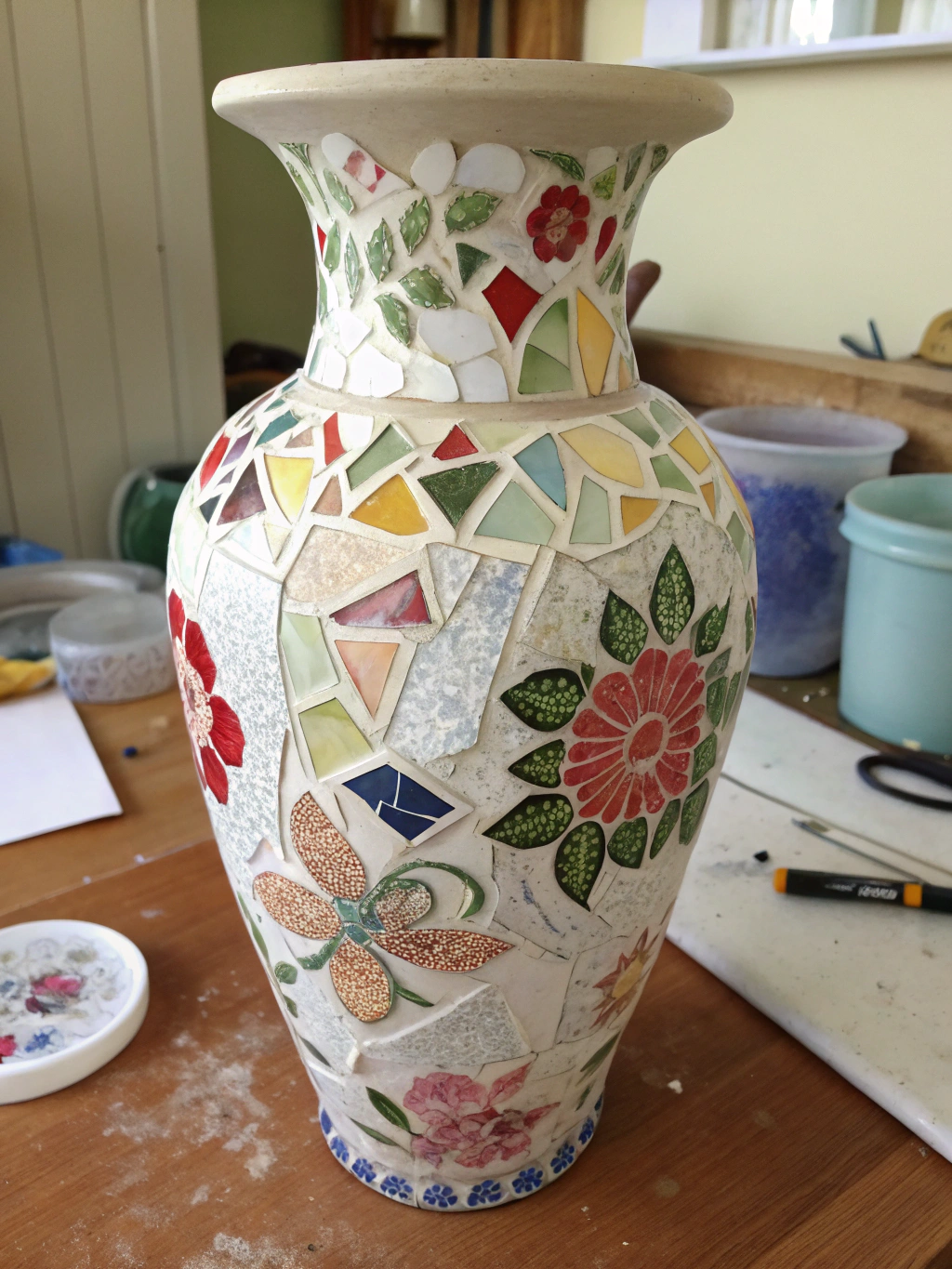
*Caption: The beautiful results of creative DIY with broken china – unique, personal, and sustainable art.*
The true joy of learning how to upcycle broken china lies not just in the finished product, but in the process of transformation. It’s a mindful, creative outlet that results in something truly special. We’d love to see what you create! Share your projects, tips, or even your “happy accidents” in the comments below.
Frequently Asked Questions (FAQs) about Upcycling Broken China
Here are answers to some common questions that might pop up as you embark on your china upcycling journey:
What’s the best way to safely break china for upcycling projects?
Place the china piece inside a sturdy cloth bag or wrap it in an old, thick towel. Set it on a firm, stable surface (like concrete outdoors, or a protected workbench). Wearing safety goggles and heavy gloves, tap the wrapped china gently but firmly with a hammer. Start with light taps and increase force as needed. This method contains the shards and minimizes flying debris, making the process safer for your “Creative DIY with broken china” endeavors.
Can I upcycle broken china for outdoor projects?
Absolutely! Broken china is excellent for outdoor projects like stepping stones, garden markers, or mosaic bird baths. The key is to use waterproof adhesives (like outdoor silicone or marine epoxy) and to seal your project with a good quality outdoor sealant if it includes grout or other porous materials. This will protect it from moisture, frost, and UV rays, ensuring your creations last for years.
What kind of adhesive is best for “Creative DIY with broken china”?
The best adhesive depends on the project. For general mosaics and attaching china to porous surfaces like wood, Weldbond or a good quality PVA craft glue can work. For non-porous surfaces, jewelry, or projects requiring extra strength and water resistance, E6000, a two-part epoxy, or specialized tile adhesive are better choices. Always read the adhesive label to ensure it’s suitable for ceramics and the other materials in your project.
Are there any specific types of china that are better for upcycling?
Most types of ceramic china, porcelain, and stoneware can be upcycled. Thinner china, like teacups, is easier to break and shape with nippers, making it ideal for delicate mosaics or jewelry. Thicker stoneware or earthenware is more robust and suitable for stepping stones or projects needing more durability. The main thing is the pattern and color – choose pieces that inspire you! Any piece can contribute to wonderful upcycle broken china ideas.
Where can I find more inspiration for “Upcycle broken china ideas, Creative DIY with broken china, How to upcycle broken china projects”?
Inspiration is everywhere! Besides this guide, check out craft blogs, Pinterest, and DIY forums. Websites like Good Housekeeping often feature “Upcycle broken china ideas, Creative DIY with broken china, How to upcycle broken china projects”. Visiting thrift stores and antique shops can also spark ideas, as you might find unique pieces perfect for your next project. And don’t forget to browse our other upcycle broken china tutorials right here on FixDIY.site!
Conclusion: Your Journey to Upcycle Broken China Begins Now!
Well, there you have it – a treasure trove of ideas and practical steps to help you upcycle broken china into something extraordinary. No longer do those shattered pieces need to represent loss or waste. Instead, view them as a palette of possibilities, waiting for your creative touch to bring them new life and purpose.
From elegant jewelry to charming garden décor, the art of transforming broken china is both rewarding and environmentally conscious. It’s a wonderful way to preserve memories, express your artistic side, and create truly unique items for your home or as heartfelt gifts. So, gather those fragments, arm yourself with a bit of adhesive and a lot of imagination, and start your upcycling adventure today!
We can’t wait to see the beautiful things you create. Share your upcycled china projects, ask questions, or leave your best tips in the comments below! And if you loved this guide, please consider sharing it with your fellow DIY enthusiasts and subscribing to our newsletter for more creative inspiration delivered straight to your inbox. Happy crafting!

